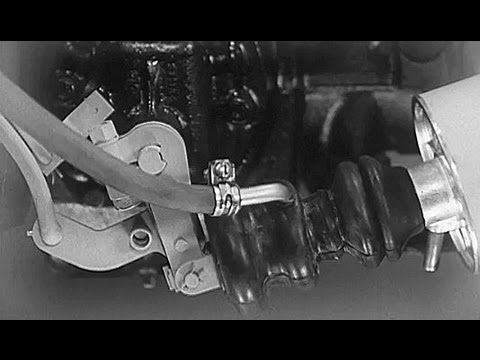Auto Mechanics: Transmissions: Vacuum Gearshift: “Free and Easy” 1940 Chevrolet
more at
“OPERATION OF THE VACUUM GEARSHIFTING MECHANISM IN THE AUTOMOBILE IS EXPLAINED & COMPARED WITH THE FISH IN THE OCEAN, WHO ARE SUBJECTED TO TREMENDOUS PRESSURE CAUSED BY THE WEIGHT OF WATER ABOVE.”
NEW VERSION with improved video & sound:
Public domain film from the Library of Congress Prelinger Archive, slightly cropped to remove uneven edges, with the aspect ratio corrected, and mild video noise reduction applied.
The soundtrack was also processed with volume normalization, noise reduction, clipping reduction, and/or equalization (the resulting sound, though not perfect, is far less noisy than the original).
AUTO MECHANICS PLAYLIST:
1939 Chevrolet
Perhaps the most interesting new feature of the 1939 Chevrolet was the “vacuum gear-shift,” a $10 option that appears to have been fitted to most of the 1939s. A short lever was mounted behind the steering wheel, leaving the floor free from the then-familiar obstruction of the shift lever.
Chevrolet claimed that “80 percent of the effort required for shifting is provided by a vacuum cylinder.” Light pressure of the fingertips was all that it took to change gears. Chevrolet retained this feature through the 1948 season, supplying it as standard equipment commencing in 1940.
However, quite a few owners complained that in time the vacuum mechanism ceased to function and shifting gears became stiff and cumbersome.
There were again two series for 1939, known this time as Master 85 and Master DeLuxe. For the first time, car-like station wagons were officially rostered, their wooden bodies supplied by several constructors. The wagons were available in both series, though technically they were classified as commercial vehicles, a fairly common practice in the early years of station wagons.
Oddly enough, however, Chevrolet did not offer a cabriolet for 1939. Perhaps this omission should come as no surprise, since only 2,787 of the ragtops had been sold during the 1938 season, but it could hardly have pleased the dealers, who often liked to keep a convertible on the floor as a showroom attraction.
The most heavily revised of the 1939 Chevrolets was the Master DeLuxe sport coupe. This time, in place of the drafty, awkward rumble seat, Chevrolet provided a pair of “jump seats” for the extra passengers. Tucked away behind the front seat, they offered somewhat cramped accommodations, but at least they provided their occupants with protection from the weather.
These seats could be readily folded up out of the way, supplying additional cargo space. This type of seating arrangement was not originated by Chevrolet. Incidentally Nash, among others, had offered it at least two years earlier. And it didn’t remain a Chevrolet feature for very long: When the 1940 models appeared, sport coupes were provided with a full-width rear seat.
Prices were reduced somewhat for 1939, and although volume still fell short of 1937’s record, Chevrolet sales forged ahead by nearly 25 percent, somewhat widening its lead over Ford. The nation’s economy was on the upswing by then, and better times were yet to come. But the phenomenal success of the 1940-1948 Chevrolet is a story for another time…

